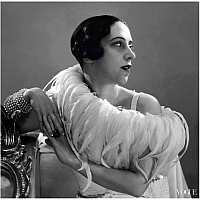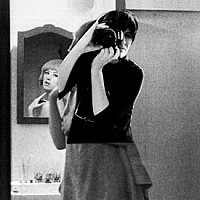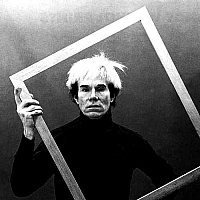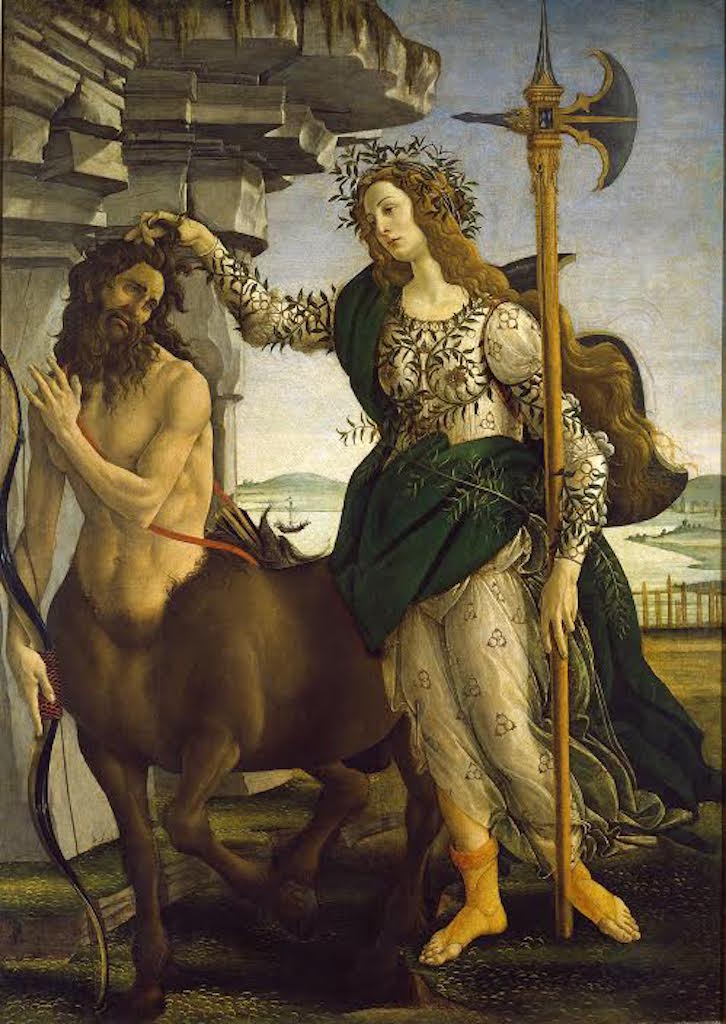
Pallas and the Centaur, c.1482 by Sandro Botticelli © Galleria degli Uffizi, Florence, 2015 Photo Scala, Florence - courtesy of the Ministero Beni e Att. Cultura
Expositions du 5/3/2016 au 3/7/2016 Terminé
Gemäldegalerie Matthäikirchplatz, Allemagne 10785 B Allemagne
Gemäldegalerie Matthäikirchplatz, Allemagne 10785 B Allemagne
Covering 500 years of art history and including over 50 great works by Sandro Botticelli (1445-1510), making it the largest exhibition of Botticelli paintings and drawings ever held in the UK, Botticelli Reimagined opens at the V&A on 5 March. This major new exhibition explores, for the first time, the variety of ways artists and designers from the Pre-Raphaelites to the present have responded to the artistic legacy of Botticelli. Including painting, fashion, film, drawing, photography, tapestry, sculpture and print, the exhibition also features works by artists as diverse as Dante Gabriel Rossetti, Edward Burne-Jones, William Morris, René Magritte, Elsa Schiaparelli, Andy Warhol and Cindy Sherman.

Venus, 1490s by Sandro Botticelli, Gemäldegalerie Staatliche Museen zu Berlin
Preußischer Kulturbesitz, Photo: Volker-H. Schneider
Botticelli is now recognised as one of the greatest artists of all time. His celebrated images are firmly embedded in the public consciousness and his influence permeates art, design, fashion and film. However, although lauded in his lifetime, Botticelli was largely forgotten for more than 300 years until his work was progressively rediscovered in the 19th century. Michael Eissenhauer, Director General of Staatliche Museen zu Berlin, said: « While the early-19th century revival of interest in Botticelli was still in its infancy, Berlin’s Gemäldegalerie already held an impressive number of works by the master and significantly shaped their renaissance in the decades to come. Today our Botticelli collection of eight paintings and 86 drawings ranks as one of the most important outside Italy, and we are delighted to have hosted the first stage of our joint exhibition to such great acclaim. »
Botticelli Reimagined is divided into three major sections:
Global, Modern, Contemporary shows how Botticelli’s imagery attained its present level of acclaim. This section is permeated by the influence of The Birth of Venus, which cannot leave the Uffizi Gallery, Florence. Andy Warhol’s Details of Renaissance Paintings (Sandro Botticelli, Birth of Venus, 1482) (1984) transforms the face and flowing hair of Botticelli’s icon in his signature bold palette while Yin Xin’s Venus After Botticelli (2008) reinterprets Venus with Asian features; and Botticelli’s composition informs David La Chapelle’s saturated and artificial Rebirth of Venus (2009). A dress and trouser suit of fragmented details from The Birth of Venus from Dolce & Gabbana’s 1993 collection are shown with two Elsa Schiaparelli evening dresses (1938) ornamented with embroidered foliage, inspired by Pallas and the Centaur. Botticelli’s influence on film includes the scene of Ursula Andress emerging from the sea clasping a conch shell from Dr No (1962) and an excerpt from Terry Gilliam’s The Adventures of Baron Munchausen (1988) with Uma Thurman. Resembling the large-scale frescoes he studied in Italy, Bill Viola’s The Path, from Going forth by Day (2002) is a digital image cycle inspired by a Botticelli composition. In 5th surgery performance - Operation opera (1994) the French artist ORLAN appears
having plastic surgery to resemble Botticelli’s Venus, in a performance series rewriting Western art through her own body. This section also includes René Magritte’s surreal Le bouquet tout fait (1957) and key works by Maurice Denis, Antonio Donghi and Robert Rauschenberg.
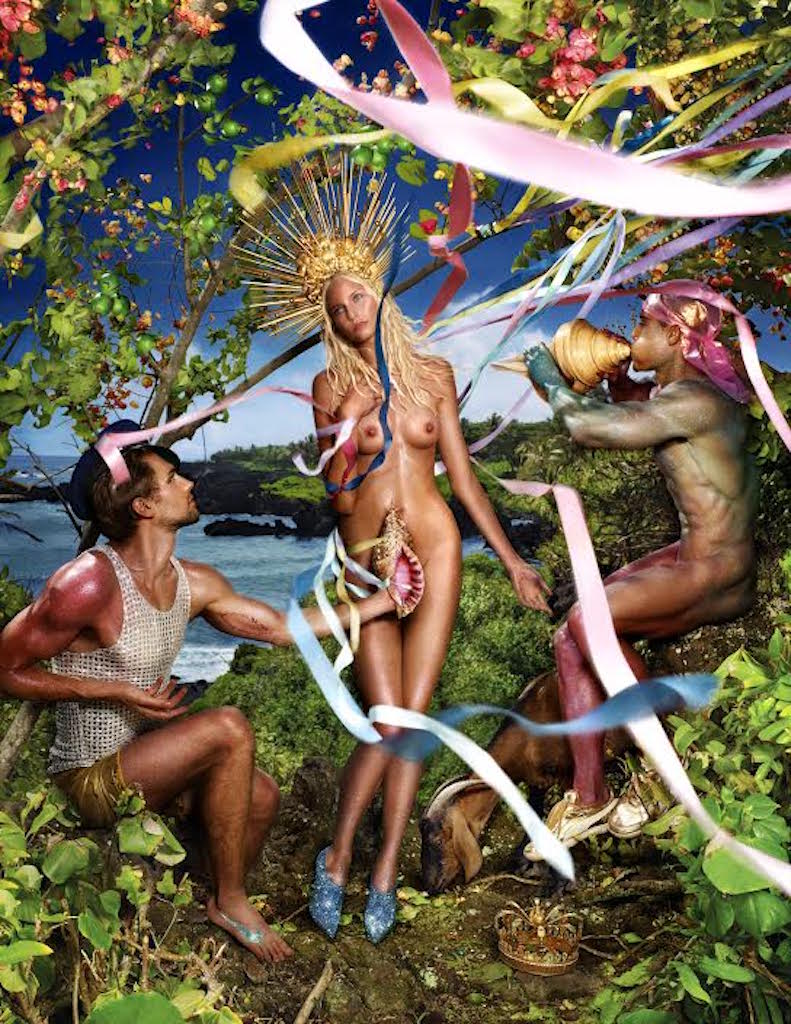
Rebirth of Venus, 2009 by David LaChapelle, Creative Exchange Agency, New York,
Steven Pranica / Studio LaChapelle © David LaChapelle
Rediscovery traces the impact of Botticelli’s art on the Pre-Raphaelite circle during the mid-19th century. Dante Gabriel Rossetti, John Ruskin and Edward Burne-Jones all acquired works by Botticelli, and his aesthetic was reinterpreted in Rossetti’s La Ghirlandata (1873) and Burne-Jones’ The Mill: Girls Dancing to Music by a River (1870-82). The Florentine master’s celebrated Primavera haunts this section, as is shown by William Morris’ The Orchard (1890), a tapestry depicting medieval ladies in a bountiful setting, Evelyn De Morgan’s Flora (1894) illustrating the nymph of flowers, and the only surviving film of Isadora Duncan dancing (c.1900). Copies of The Birth of Venus by Edgar Degas and Gustave Moreau (1859) as well as Etienne Azambre’s Two Women copying Botticelli’s fresco of Venus and the Graces (1894) demonstrate the vogue for copying his work. Botticelli’s European influence is manifest in major paintings by Jean-Auguste-Dominique Ingres, Arnold Böcklin and Giulio Aristide Sartorio.
Botticelli in his Own Time shows that Botticelli was both a supremely skilled artist and a designer of genius who ran a highly successful workshop. Exhibits include his only signed and dated painting The Mystic Nativity (1500), three portraits supposedly of the legendary beauty Simonetta Vespucci, and the exquisitely detailed Pallas and the Centaur (1482), travelling to London for the first time. A number of variations on the Virgin and Child theme in different formats illustrate Botticelli’s creativity as a designer, while his skill as a draughtsman is evident in a spectacular group of drawings including five of his lyrical illustrations of Dante’s Divine Comedy. The show closes with two monumental full-length paintings of Venus, reprising the heroine of The Birth of Venus, and also features the V&A’s Portrait of a Lady known as Smeralda Bandinelli (c. 1470-5), formerly owned by Rossetti and restored especially for this exhibition.


